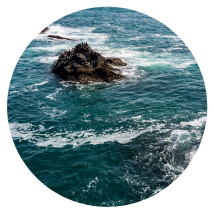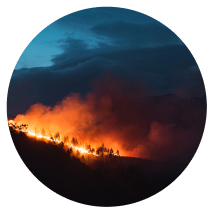Why did the Frontiers Research Foundation create the Frontiers Planet Prize?
The challenge
The environmental and ecological challenges facing our planet are colossal, demanding immediate attention. They can be tackled only with a concerted global effort and an intelligent, pragmatic approach, and by uncovering the best ideas in the field of planetary boundary science.
Scientists working within earth system sciencehave identified nine planetary boundaries that should not be crossed, as described by Professor Johan Rockström and Owen Gaffney in their book Breaking Boundaries.
The current state of scientific knowledge makes a convincing case that urgent action is needed to prevent humanity from crossing these boundaries. Science tells us the window of opportunity for action is limited and we need to act now. This is the main ambition for the creation of the Frontiers Planet Prize: to mobilize the scientific community to speed up the search for planetary solutions.
Planetary boundaries
and tipping points
The scientists researching the nine planetary boundaries defined the quantitative limits not to be crossed. Crossing these boundaries, increases the risk of irreversible, runaway, environmental change, threatening healthy lives on a healthy planet. The planetary boundaries are described as follows:
A safe operating space for humanity
J. Rockstörm et al (2009)
REFERENCE
The ozone layer absorbs ultraviolet radiation from the Sun and thereby serves as our protective shield for life on Earth. The planetary boundary is set to a minimum thickness of 275 DU (Dobson Units, related to the thickness of the ozone layer in millimeters). Currently, we are within the ozone boundary.
Biodiversity is key to the resilience of nature and supports Earth to resist changes. Humans are driving numerous species to extinction – a big threat to Earth’s ecosystem. We have already entered the danger zone by crossing the boundary for biodiversity.
To feed the world we need crops – and crops need sunlight, water and nutrients, such as nitrogen and phosphorus. By the overloading of nutrients through biogeochemical flows, the Earth has moved far beyond the boundary for the use of nitrogen and phosphorus.
In order to stay well below of 1.5°C global warming, the climate boundary is set to bring carbon dioxide levels in the atmosphere back down to below 350 ppm. Currently, we are at 418 ppm (with global carbon emissions steadily increasing). We have already entered the high danger zone.
There are about 350.000 man-made artificially produced chemicals on the global market - ranging from plastics to pesticides, and nuclear waste – and many of which enter our environment. A most recent study found that humanity exceeded the novel entities boundary – we entered the danger zone.
Lots of small particles (aerosols) are released daily into the atmosphere from, e.g., industrial processes, burning fossil fuels, and car exhausts. The aerosols accumulate leading to air pollution affecting, e.g., weather systems and causing millions of deaths per year. Due to large uncertainties a precise global boundary has not yet been quantified.
In order to keep a balance between Earths different ecosystems, biomass is a critical factor. Today, we have already altered 50% of all land surfaces and deforested 62% of original forest cover. We have crossed the land use boundary (assessed at keeping 75% original forest cover) by far and entered the danger zone.
The ocean absorbs about a quarter of our carbon dioxide emissions. As a consequence, the ocean has already become 30% more acidic impacting many ocean species (especially corals and oysters which make hard skeletons and shells). While we already observe widespread annual bleaching of coral reefs, Earth is still within the ocean acidification boundary, but approaching it rapidly.
Water is essential for life on Earth. If we withdraw too much water, ecosystem functions will suffer severely. Science assessments show that we can use 10 to 15% of the total water runoff on Earth; 50% for waters in rivers. The freshwater boundary has been crossed locally already in many places – we just entered the danger zone.









